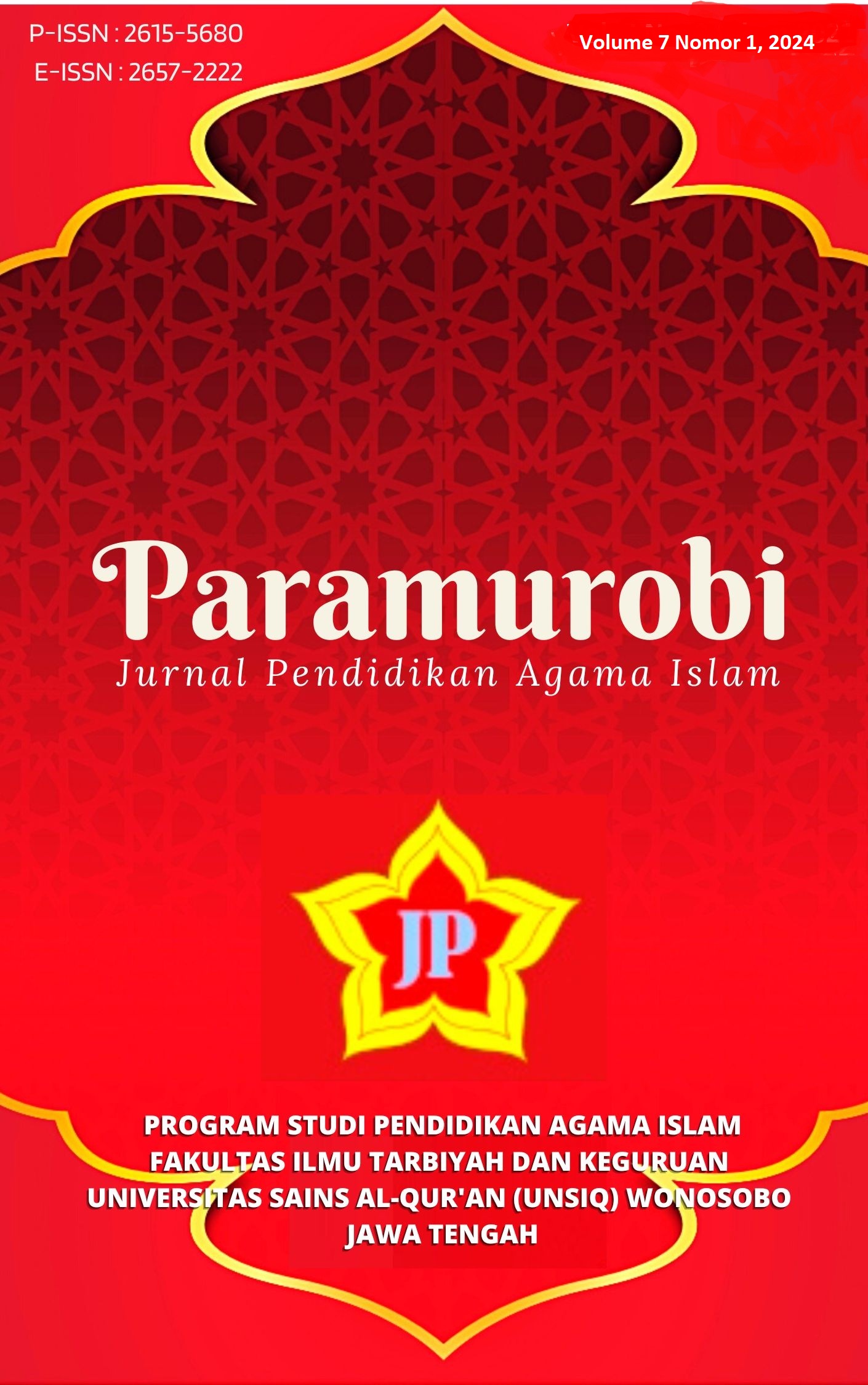ANALISIS GAMBAR STIMULUS PADA PERMULAAN BAB BUKU AJAR PAI KELAS VIII PRESPEKTIF VISUAL DAN PENDIDIKAN
DOI:
https://doi.org/10.32699/paramurobi.v7i1.7018Keywords:
Keywords: Stimulus, Visual, EducationAbstract
Analysis of stimulus images at the beginning of the 8th grade Islamic Religious Education (PAI) textbook chapter highlights the important role of visuals in the context of religious learning. This research adopts a qualitative perspective with a focus on content, semiotic, and visual analysis to understand how these images influence students' perceptions and facilitate deep learning. Through this approach, we reveal the various messages, themes and values implicit in these images, as well as how visual elements such as composition, color and symbolism are used to convey Islamic religious concepts. The results of this research provide valuable insight into the potential of stimulus images as an effective tool in enriching students' learning experiences in religious subjects, as well as highlighting the importance of integrating visual aspects in the religious education process. The practical implications of these findings can enrich PAI learning designs that are more responsive to students' needs and preferences in visual contexts.
References
Asy-Syahrastani, M. (2006). Al-Milal wa An-Nihal (Buku 1-3).
Aswan, Rifki. “Tinjauan Elemen Visual pada buku ilustrasi #88 Love Live.” NARADA: Jurnal Desain & Seni 06, no. 01 (2019): 187–214.
Ch, Mufidah. “Strategi Implementasi Pengarusutamaan Gender Bidang Pendidikan Islam.” Al-Tahrir: Jurnal Pemikiran Islam 11, no. 2 (1 November 2011): 391. https://doi.org/10.21154/al-tahrir.v11i2.41.
Farida, Neng Awalia. dkk. “Penerapan Media Gambar dalam Pembelajaran PAI Pada Anak Usia Dini”, Jurnal El-Audi, Vol. 3, No. 1, 2022: 12-16.
Galingging, Rumbel. “Analisis Desain Cover Buku Anak Ayo Sekolah Lukisan Aini.” Magenta | Official Journal STMK Trisakti 4, no. 01 (29 Januari 2020): 583–93. https://doi.org/10.61344/magenta.v4i01.71.
Glaw, Xanthe, Kerry Inder, Ashley Kable, dan Michael Hazelton. “Visual Methodologies in Qualitative Research: Autophotography and Photo Elicitation Applied to Mental Health Research.” International Journal of Qualitative Methods 16, no. 1 (Desember 2017): 160940691774821. https://doi.org/10.1177/1609406917748215.
Hassan, M. (2015). The Qur'an and the Sunnah. Cambridge: Islamic Texts Society.
Hariyantoni, Masduki. “Penggunaan Media Gambar pada Mata Pelajaran Pendidikan Agama Islam Materi Shalat Jenazah di Kelas IX J SMP Negeri 1 Kuningan Kabupaten Kuningan”, Al-Tarbawi Al-Haditsah: Jurnal Pendidikan Islam, pISSN: 2407-6805, Vol. 4, No 1, Juni 2019, 168.
Jampel, I Nyoman, dan Kadek Riza Puspita. “Peningkatan Hasil Belajar Siswa Sekolah Dasar Melalui Aktivitas Pembelajaran Mengamati Berbantuan Audiovisual.” International Journal of Elementary Education 1, no. 3 (8 September 2017): 197. https://doi.org/10.23887/ijee.v1i3.10156.
Khotimah, Husnul, Asep Supena, dan Nandang Hidayat. “Meningkatkan attensi belajar siswa kelas awal melalui media visual.” Jurnal Pendidikan Anak 8, no. 1 (21 Agustus 2019): 17–28. https://doi.org/10.21831/jpa.v8i1.22657.
Magdalena, Ina, Amanda Khofifah, dan Fitri Auliyah. “BAHAN AJAR.” Sindoro: Cendikia Pendidikan 2, no. 6 (2024): 21–30.
Muchith, Saekan, Pengembangan Kurikulum Pendidikan Agama Islam (PAI) Berbasis moderasi beragama¸ (Yogyakarta : PT. Nas Media Indonesia), 69-72.
Purbasari, Mita, dan R.A. Diah Resita I. K. Jakti. “Warna Dingin Si Pemberi Nyaman.” Humaniora 5, no. 1 (1 April 2014): 357. https://doi.org/10.21512/humaniora.v5i1.3034.
Saputra, Miswar. dkk., Pengembangan Kurikulum Pendidikan Agama Islam, (Aceh : Yayasan Penerbit Muhammad Zaini, 2021), 27.
Suhardiana, I Putu Andre. “PERAN TEKNOLOGI DALAM MENDUKUNG PEMBELAJARAN BAHASA INGGRIS DI SEKOLAH DASAR.” Adi Widya: Jurnal Pendidikan Dasar 4, no. 1 (23 Juli 2019): 92. https://doi.org/10.25078/aw.v4i1.934.
Surani, Dewi. dkk., Konsep Dasar Media Pembelajaran, (Batam : Yayasan Cendikia Mulia Mandiri, 2022), 2.
Downloads
Published
Issue
Section
License
Copyright Notice
1. Authors retain copyright and grant the journal right of first publication with the work simultaneously licensed under a Creative Commons Attribution License (CC BY-SA 4.0) that allows others to share (copy and redistribute the material in any medium or format), and adapt (remix, transform, and build upon the material) the work for any purpose, even commercially with an acknowledgement of the work's authorship and initial publication in this journal.
2. Authors are able to enter into separate, additional contractual arrangements for the non-exclusive distribution of the journal's published version of the work (e.g., post it to an institutional repository or publish it in a book), with an acknowledgement of its initial publication in this journal.
3. Authors are permitted and encouraged to post their work online (e.g., in institutional repositories or on their website) prior to and during the submission process, as it can lead to productive exchanges, as well as earlier and greater citation of published work (See The Effect of Open Access).





